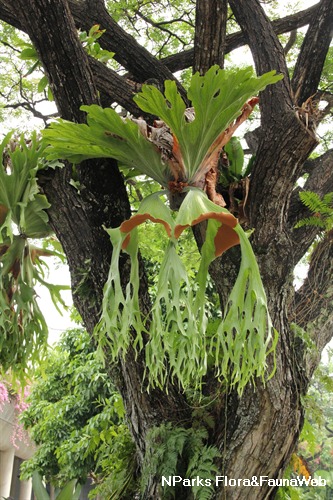
Back
Platycerium coronarium (J. Koenig ex O. F. Müll.) Desv.
| Family Name: | Polypodiaceae |
| Synonyms: | Platycerium biforme Blume. |
| Common Name: | Staghorn Fern, Crown Staghorn, Stag's Horn Fern, Disc Stag's Horn Fern, Elkhorn Fern, Semum Bidadari, Rumah Langsuyar, Paku Langsuyar, 皇冠鹿角蕨 |
Platycerium coronarium or Staghorn Fern is an epiphytic fern that can grow to 3 m long and 1.5 wide. It has two types of fronds; the sterile nest fronds and fertile foliage fronds. The nest fronds are shaped into a crown-like baskets while the foliage fronds hang underneath are pendulous, dividing several times forming a net-like structure. Once mature enough, the foliage frond produce a semi-circular lobe coated with brown coloured sporangia (spore bearing structures). This native fern is often perched upper branches of mature trees, sheltered by their large canopy or mounted on fern root slabs in cultivation.
Name
Classifications and Characteristics
| Plant Division | Ferns & Lycophytes (Non-Seed Vascular Plants) (Fern) |
|---|---|
| Plant Growth Form | Epiphyte |
| Lifespan (in Singapore) | Perennial |
| Mode of Nutrition | Autotrophic |
| Maximum Height | 3 m |
| Maximum Plant Spread / Crown Width | 1.5 m |
Biogeography
| Native Distribution | Cambodia, Laos, Myanmar, Thailand, Vietnam, West and Central Malesia |
|---|---|
| Native Habitat | Terrestrial (Primary Rainforest, Secondary Rainforest, Monsoon Forest) |
| Preferred Climate Zone | Tropical, Sub-Tropical / Monsoonal |
| Local Conservation Status | Native to Singapore (Endangered (EN)) |
Description and Ethnobotany
| Growth Form | Large epiphytic fern (up to 3m long by 1.5m across when fully grown), with short and fleshy branched rhizome hidden in basin formed by upper fronds. |
|---|---|
| Foliage | Plant produces 2 types of fronds. Infertile nest-fronds are fan-shaped and topped by erect lobed 'fingers', growing together to form crown-like basket to trap leaf detritus from host tree. New nest-fronds successively produced on the outside to replace aged fronds, which die and curl up to grip the leaf litter inside. Fern's roots grow into this mass of decaying leaves for moisture and nutrients. Fertile fronds are narrowly linear and long (up to 2 m), limply pendulous, bifurcating repeatedly to form hanging net-like structure below nest-fronds. Underside of frond holds semi-circular ear-like lobes densely coated with brown sporangia (sacs with reproductive spores). Aged fertile fronds are shed from fern. |
| Habitat | Found perched on upper branches of mature trees (especially those with wide spreading crowns and sparser foliage) in lowland rainforests, mangrove forests and along roadsides. |
| Associated Flora | Closely associated with Ophioglossum pendulum (Adder's Tongue Fern), whose spores develop in the nest-fronds of Staghorn, and draws nutrients from the host-fern via a fungus intermediary, until it emerges with long ribbon-like fronds that descend from the host-fern. |
| Associated Fauna | Plant is known to die off naturally after a few years, and dead nest-fronds continue to serve as habitat for other ferns, as well as snakes and rats. |
| Cultivation | Can be mounted directly on tree branches / trunks, or tied to fern root slabs. Suitable for semi-shady to full sun sites. Prefers well-drained conditions, so allow 'nest' to dry out before watering. Feed with slow-release fertilizers like fish emulsion, or use potassium-rich banana peels (place whole or cut up peel amongst the nest-fronds). Propagate by spores. |
| Etymology | Genus epithet Platycerium derived from Greek terms 'platys' (broad) and 'keras' (horn), a reference to the antler-like nest-fronds. Species epithet 'coronarium' means 'crown', describing how the nest-fronds are arranged. |
| Ethnobotanical Uses | Food (Herb or Spice) Others: Ashes used in Malay folk medicine as body-rub to treat enlarged spleen. |
Landscaping Features
| Desirable Plant Features | Ornamental Foliage |
|---|---|
| Landscape Uses | General, Interiorscape/ Indoor Plant, Vertical Greenery / Green Wall |
| Thematic Landscaping | Naturalistic Garden |
| Plant & Rootzone Preference or Tolerance Remarks | Grows as an epiphyte on tree branches or fern root slabs. |
Fauna, Pollination and Dispersal
| Seed or Spore Dispersal | Abiotic (Wind) |
|---|
Plant Care and Propagation
| Light Preference | Semi-Shade, Full Sun |
|---|---|
| Water Preference | Moderate Water, Occasional Misting |
| Plant Growth Rate | Moderate |
| Rootzone Tolerance | Shallow Media |
| Pruning | No pruning required |
| Diseases | May be susceptible to scale insects. |
| Propagation Method | Spore |
| Maintenance Requirements Remarks | Known to die back naturally after a few years. |
Foliar
| Foliage Retention | Evergreen |
|---|---|
| Mature Foliage Colour(s) | Green |
| Mature Foliage Texture(s) | Leathery |
| Foliar Type | Simple / Unifoliate |
| Foliar Arrangement Along Stem | Basal |
| Foliar Attachment to Stem | Sessile |
| Foliar Shape(s) | |
| Foliar Venation | Dichotomous |
| Foliar Margin | Entire |
Non - Foliar and Storage
| Stem Type & Modification | Acaulescent |
|---|---|
| Root Type | |
| Specialised Storage Organ(s) |
Fruit, Seed and Spore
| Plant Sexuality (non-Angiosperm) | Monoecious |
|---|---|
| Reproductive Mode (non-Angiosperm) |
References
| References | Hovenkamp, P.H. (1998). Polypodiaceae. Flora Malesiana - Series 2, Pteridophyta, 3(1), pp. 1 - 234. Royal Botanic Gardens, Kew (continuously updated). Plants of the World Online | Kew Science. https://powo.science.kew.org/taxon/urn:lsid:ipni.org:names:17237070-1. Accessed 13 January 2022. |
|---|
Image Repository
Others
| Master ID | 266 |
|---|---|
| Species ID | 1562 |
| Flora Disclaimer | The information in this website has been compiled from reliable sources, such as reference works on medicinal plants. It is not a substitute for medical advice or treatment and NParks does not purport to provide any medical advice. Readers should always consult his/her physician before using or consuming a plant for medicinal purposes. |






.jpg)
.jpg)
-(16).jpg)


